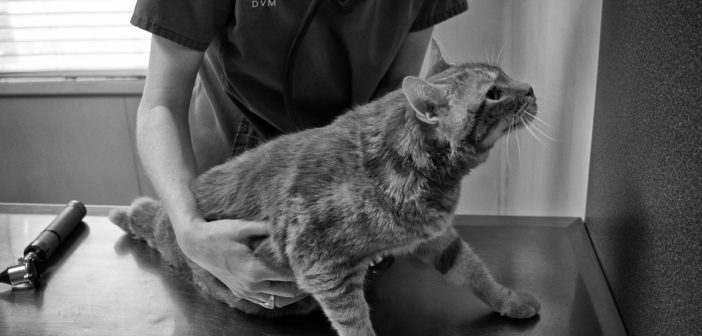Many people consider veterinarians to be the ultimate animal lovers, having focused their careers on helping animals in a very tangible way. In light of this perception, it may be surprising to learn that a large component of most veterinary training involves harmfully using animals. These animals are used as models for learning various veterinary procedures, many of which are highly invasive and potentially painful. The animals used are often killed at the end of practice surgeries.
Technologies that can serve as alternatives to live animal use have existed for decades and are continuously improving. These technologies include models, mannequins and simulators that help veterinary students practice specific skills and procedures, such as intubation, surgery, or various clinical examinations.

A canine spay training mannequin. Image credit: Vet Effects.
Using models to learn veterinary skills isn’t just more humane, it’s also just as effective a form of teaching. Professor Andrew Knight of the University of Winchester Centre for Animal Welfare demonstrated in a 2012 review of existing research on humane veterinary teaching methods that 90% of published studies showed humane methods had either the same or better learning outcomes than using live animals.
Prof. Knight points out that humane methods are superior in other ways beyond their proven ability to teach skills, such as their lack of dangerous chemicals, which are often used to preserve purposefully killed animals, and can be harmful to humans. Additionally, participating in harmful live animal use can result in “powerful emotional experiences and high levels of stress” for veterinary students, which can negatively impact learning outcomes and cause conflict between teaching staff and students.
Finally, and perhaps unsurprisingly, routinely harming animals as part of their training desensitizes veterinarians-to-be to animal suffering, an outcome which should be directly at odds with the aims of their future careers:
“Student participation in harmful animal use appears to contribute to a range of desensitization-related phenomena, which adversely affect awareness of animal welfare problems and the desire to take appropriate action to redress them. Such adverse attitudinal impacts have the potential to decrease the ability of veterinarians to safeguard and promote good welfare for their patients and animals generally.”
Harmful animal use, then, is harmful for everyone: the animals used, the people training to be veterinarians, and their future animal patients.
Despite this, harmful animal use persists in many veterinary schools and training programs, and unfortunately many teaching faculty remain resistant to exploring alternatives and unaware of their proven efficacy. In an effort to change this, Prof. Knight and Prof. Bernard Grevemeyer recently published an article detailing the process of planning, implementing, and running a clinical skills training laboratory at Ross University School of Veterinary Medicine (RUSVM) in Saint Kitts.
The article shares their experiences and triumphs in building and maintaining the laboratory, and serves as a valuable resource to other programs interested in developing similar projects. RUSVM graduates 300-400 students a year, and their humane Clinical Skills Laboratory was created in 2008. What started then with the limited capacity to teach a few surgical skills has grown considerably, and now includes facilities for teaching a wide range of skills including phlebotomy, resuscitation techniques, various surgical skills, and intravenous catheterisation.
Encouragingly, a survey of RUSVM students found that 95% felt that the Clinical Skills Laboratory sessions had improved their psychomotor skills.
One of the main perceived barriers to implementing the use of these types of models and mannequins is the initial costs of purchasing them. Indeed, Profs. Knight and Grevemeyer note that the costs of the models varies, with some being quite expensive. To overcome this, and to continue to improve their models, RUSVM has begun designing and creating their own, including through the use of MRI imaging and 3D printing. They note that the availability of these technologies opens new doors in terms of affordability, realism, and customizability.
RUSVM’s humane Clinical Skills Laboratory serves as an exciting example of how veterinary schools can successfully move forward without harmfully using animals. The report on their program should hopefully serve to spread their methods and encourage others to follow in their footsteps.
Read the entire 2018 report here: The Development of a Clinical Skills Laboratory at Ross University School of Veterinary Medicine.
Reference:
Grevemeyer, B., and Knight, A. (2018). The development of a clinical skills laboratory at Ross University School of Medicine. Alternatives to Laboratory Animals, 46(3), 177-183.
Featured image: Veterinarian examines a cat. Image credit Anne Worner, CC BY-SA 3.0





